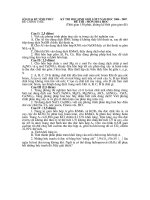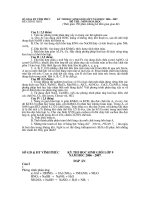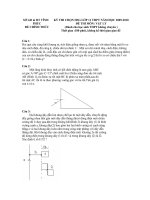De thi DBSCL tinh Vinh Long
Bạn đang xem bản rút gọn của tài liệu. Xem và tải ngay bản đầy đủ của tài liệu tại đây (79.64 KB, 4 trang )
IV. READING: ( 3 pts )
A. Read the following passage carefully, then choose the correct answer: (0.5 pt )
Hundreds of thousands of persons each year fall prey to some type of cancer, but new
methods of radiation therary have enabled doctors to save more lives than ever before. Medical
researches have developed several effective in fighting the disease.
One promising approach involves exposing cancer cells to radiation by implanting a
radioactive source directly into the malignant tissue. This process greatly increases the dosage
and thus the effectiveness of the treatment. Another technique utilizes drugs to make cancer cells
more susceptible to the effects of radiation and to make normal cells more resistant. Certain drugs
are able to neutralize the genetic framework of cancer cells, thus making them more easily affected
by radiation. Both techniques have seen some positive results in the treatment of inoperable brain
tumors.
These and other methods have helped to raised the recovery rate for cancer victims from 30
percent 40 years ago to around 50 percent today. This is encouraging news for those who fall prey
to one of the world’s leading killers.
1. What’s the author’s main purpose in the passage ?
A. To provide statistical information on cancer.
B. To argue for new methods of cancer treatment.
C. To illustrate new techniques of radiation therapy.
D. To give the results of recent cancer research.
2. According to the passage, which of the following is true about radiation therapy ?
A. There is only one effective form of this therapy.
B. It saves millions of lives each year.
C. It is an accepted method of cancer treatment.
D. It causes the incidence of cancer to rise dramatically.
3. In line 5, the word malignant most closely means
A. diseased B. experimental C. treated D. porous
4. According to the passage, radiation therapy is most effective when
A. drugs are used to relax the cancer patient.
B. the cancer is directly exposed to the radioactive material.
C. it is used on as many patients as possible.
D. the cancer cells are resistant to treatment.
5. It can be inferred from the passage that
A. improvements in cancer treatment during the last half century have been
realtively ineffective.
B. the number of deaths caused by cancer has decreased substantially.
C. fewer people are susceptible to the effects of cancer.
D. scientists are close to eliminating cancer entirely.
ANSWER KEY: ( 0.5 pt 0.1 pt / each )
1. C 2. C 3. A 4. B 5. B
( Trường THPT Chuyên Thoại Ngọc Hầu – An Giang )
IV. READING: ( 3 pts )
A. Read the following passage carefully, then choose the correct answer: (0.5 pt )
Hundreds of thousands of persons each year fall prey to some type of cancer, but new
methods of radiation therary have enabled doctors to save more lives than ever before. Medical
researches have developed several effective in fighting the disease.
One promising approach involves exposing cancer cells to radiation by implanting a
radioactive source directly into the malignant tissue. This process greatly increases the dosage
and thus the effectiveness of the treatment. Another technique utilizes drugs to make cancer cells
more susceptible to the effects of radiation and to make normal cells more resistant. Certain drugs
are able to neutralize the genetic framework of cancer cells, thus making them more easily affected
by radiation. Both techniques have seen some positive results in the treatment of inoperable brain
tumors.
These and other methods have helped to raised the recovery rate for cancer victims from 30
percent 40 years ago to around 50 percent today. This is encouraging news for those who fall prey
to one of the world’s leading killers.
4. What’s the author’s main purpose in the passage ?
A. To provide statistical information on cancer.
B. To argue for new methods of cancer treatment.
C. To illustrate new techniques of radiation therapy.
D. To give the results of recent cancer research.
5. According to the passage, which of the following is true about radiation therapy ?
A. There is only one effective form of this therapy.
B. It saves millions of lives each year.
C. It is an accepted method of cancer treatment.
D. It causes the incidence of cancer to rise dramatically.
6. In line 5, the word malignant most closely means
A. diseased B. experimental C. treated D. porous
4. According to the passage, radiation therapy is most effective when
A. drugs are used to relax the cancer patient.
B. the cancer is directly exposed to the radioactive material.
C. it is used on as many patients as possible.
D. the cancer cells are resistant to treatment.
5. It can be inferred from the passage that
A. improvements in cancer treatment during the last half century have been
realtively ineffective.
B. the number of deaths caused by cancer has decreased substantially.
C. fewer people are susceptible to the effects of cancer.
D. scientists are close to eliminating cancer entirely.
B. Read the following passage carefully, then decide whether each sentence is true or false:(0.1pt )
When people think of movies, they usually think of Hollywood. However, many of the
earliest tools relating motion pictures were not American inventions. It was thanks to the efforts of
inventors from several countries that we can enjoy movies today.
In the early 1800s an Englishman named William George Horner invented the zoetrope. In it
a series of pictures were mounted inside a drum. When the rotating pictures were viewed through
slot, they merged into one and appeared to move. In California in 1877, another Englishman named
Eadweard Myubridge, used a series of cameras to record the movements of a galloping horse.
Later, he also recorded human movements. He used his still pictures to illustrate books; thus it was
left to the German, Ottomar Anschutz, to invent a way to rapidly show the picture series to give the
impression of movement. Finally, it took a Frenchman, Etienne Jules Marey, to develop a single
camera to record movement. Marey shots his pictures on fixed plates, at the rate of 12 per second.
As early as 1888 he was experimenting with celluloid film, an American invention.
While Thomas Edison was busy inventing something called the kinetograph camera, Louis
Le Prince of france was patenting a 16-lens camera to make moving pictures and a projector to
show them. By the following year he was working with a single-lens camera. Unfortunately, in 1890
Le Prince suddenly disappeared from the train in which he was travelling and vanished forever,
Taking up what Le Prince left were Louis and Auguste Lumiere, who gave the world’s first projected
film performance, before a paying audience in Paris on December 28
th
, 1895. Motion pictures have
become a long way since those early days and have had a great influence on society. It was thanks
to the contributions of filmmakers and inventors from all over the world that movies have developed
in the form we know today.
1. Hollywood is the place where film was first invented.
2. The movements of a galloping horse were recorded before human movements were.
3. Auguste Lumiere disappeared secrectly when he was travelling on a train.
4. The world’s first projected film was shown in Paris.
5. Films have had great influence on society.
B. Read the following passage carefully, then decide whether each sentence is true or false:(0.1pt )
When people think of movies, they usually think of Hollywood. However, many of the
earliest tools relating motion pictures were not American inventions. It was thanks to the efforts of
inventors from several countries that we can enjoy movies today.
In the early 1800s an Englishman named William George Horner invented the zoetrope. In it
a series of pictures were mounted inside a drum. When the rotating pictures were viewed through
slot, they merged into one and appeared to move. In California in 1877, another Englishman named
Eadweard Myubridge, used a series of cameras to record the movements of a galloping horse.
Later, he also recorded human movements. He used his still pictures to illustrate books; thus it was
left to the German, Ottomar Anschutz, to invent a way to rapidly show the picture series to give the
impression of movement. Finally, it took a Frenchman, Etienne Jules Marey, to develop a single
camera to record movement. Marey shots his pictures on fixed plates, at the rate of 12 per second.
As early as 1888 he was experimenting with celluloid film, an American invention.
While Thomas Edison was busy inventing something called the kinetograph camera, Louis
Le Prince of france was patenting a 16-lens camera to make moving pictures and a projector to
show them. By the following year he was working with a single-lens camera. Unfortunately, in 1890
Le Prince suddenly disappeared from the train in which he was travelling and vanished forever,
Taking up what Le Prince left were Louis and Auguste Lumiere, who gave the world’s first projected
film performance, before a paying audience in Paris on December 28
th
, 1895. Motion pictures have
become a long way since those early days and have had a great influence on society. It was thanks
to the contributions of filmmakers and inventors from all over the world that movies have developed
in the form we know today.
6. Hollywood is the place where film was first invented.
7. The movements of a galloping horse were recorded before human movements were.
8. Auguste Lumiere disappeared secrectly when he was travelling on a train.
9. The world’s first projected film was shown in Paris.
5. Films have had great influence on society.
ANSWER KEY: ( 0.5 pt 0.1 pt / each )
1. F 2. T 3. F 4. T 5. T
( Trường THPT Chuyên Thoại Ngọc Hầu )









